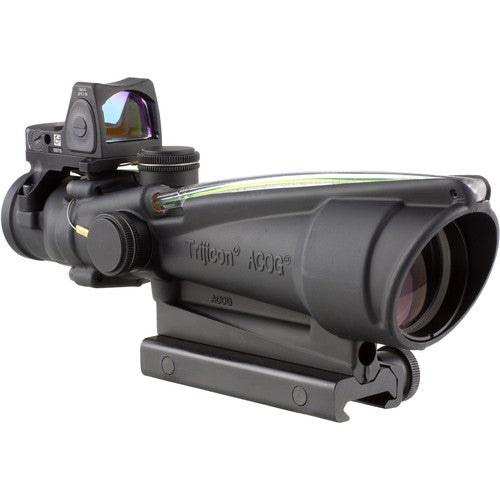

Trijicon ACOG 3.5x35 Riflescope & 3.25 MOA Red Dot Type 2 RMR Kit features a robust optical design tailored for precision shooting and tactical operations. With a 3.5x magnification and a 35mm objective lens, this riflescope provides a wide field of view of 28.9 feet at 100 yards. The green chevron reticle is specifically designed for .223 caliber rifles, enabling accurate targeting up to 1000 meters. The dual-illuminated reticle, powered by fiber optics and tritium, ensures visibility in various lighting conditions without needing batteries.
This kit also includes a 3.25 MOA Red Dot Type 2 RMR for quick target acquisition in close-quarters situations. Built to endure harsh environments, this scope is waterproof and shock-resistant, making it ideal for military personnel, law enforcement, and serious shooting enthusiasts who prioritize reliability and performance in their optics.
Key Features:
- DUAL SIGHT SYSTEM: Combines a 3.5x35 ACOG riflescope with a 3.25 MOA Red Dot Type 2 RMR for versatile targeting at various ranges.
- ADVANCED RETICLE: Green chevron .223 ballistic reticle calibrated for 5.56 (.223 cal) flat-top rifles, offering precise aiming points up to 1000 meters.
- DUAL ILLUMINATION: Fiber optics for daylight illumination and tritium for low-light conditions, ensuring reticle visibility without batteries.
- RUGGED CONSTRUCTION: Waterproof and shock-resistant design built to withstand harsh environments and heavy recoil.
- WIDE FIELD OF VIEW: 28.9 feet at 100 yards, providing excellent situational awareness and target acquisition.
- EASY ADJUSTMENTS: 1/2 MOA click value for precise zeroing, with counter-clockwise turret rotation.
- COMFORTABLE VIEWING: 2.4-inch eye relief and a 10.0 mm exit pupil for comfortable extended use.
- COMPACT DESIGN: 8-inch overall length and 14 oz weight (without mount) for minimal impact on weapon balance.
Technical Specifications
| Specification | Detail |
|---|---|
| Model/SKU | TA11-C-100565 |
| Magnification | 3.5x |
| Objective Lens Diameter | 35mm |
| Reticle | Green Chevron .223 Ballistic |
| Illumination | Fiber Optics & Tritium (Amber, Red, Green) |
| Field of View | 28.9 ft @ 100 yards |
| Eye Relief | 2.4 inches |
| Exit Pupil | 10.0 mm |
| Length | 8 inches |
| Weight (w/o mount) | 14 oz |
| Adjustment Click Value | 1/2 MOA |
| Turret Rotation | Counter Clockwise (CCW) |
| Parallax Setting | Fixed |
| Waterproof | Yes |
| RMR Dot Size | 3.25 MOA |
| UPC | 719307311954 |
| MPN | 100565 |
What's in the Box?
- Trijicon ACOG 3.5x35 Riflescope
- Trijicon RMR Type 2 Red Dot Sight
- Mounting hardware
- User manual
- Warranty information
Customer Reviews
“The clarity and accuracy of this scope are unmatched. Perfect for my tactical training.”
“I’ve used it in various weather conditions, and it holds up beautifully. Highly recommend!”
FAQ
How does the dual sight system work? The ACOG provides magnified targeting for longer distances, while the RMR allows for quick, close-quarters engagement. This combination enhances versatility in various shooting scenarios.
Is the ACOG suitable for low-light conditions? Yes, the dual illumination system with fiber optics and tritium ensures visibility in low-light environments without battery reliance, making it ideal for tactical operations at dusk or dawn.
How durable is this riflescope? The ACOG is engineered with a waterproof and shock-resistant design, ensuring it can withstand harsh conditions and heavy recoil, making it suitable for military and law enforcement applications.
Similar Models
Looking for more options? Check out Trijicon’s extensive range of tactical optics, including models like the Trijicon VCOG for variable magnification and the Trijicon MRO for a lightweight reflex sight. Explore our full collection to find the right optic for your needs.
You May Also Like
Here’s some of our most similar products people are buying. Click to discover trending style.










